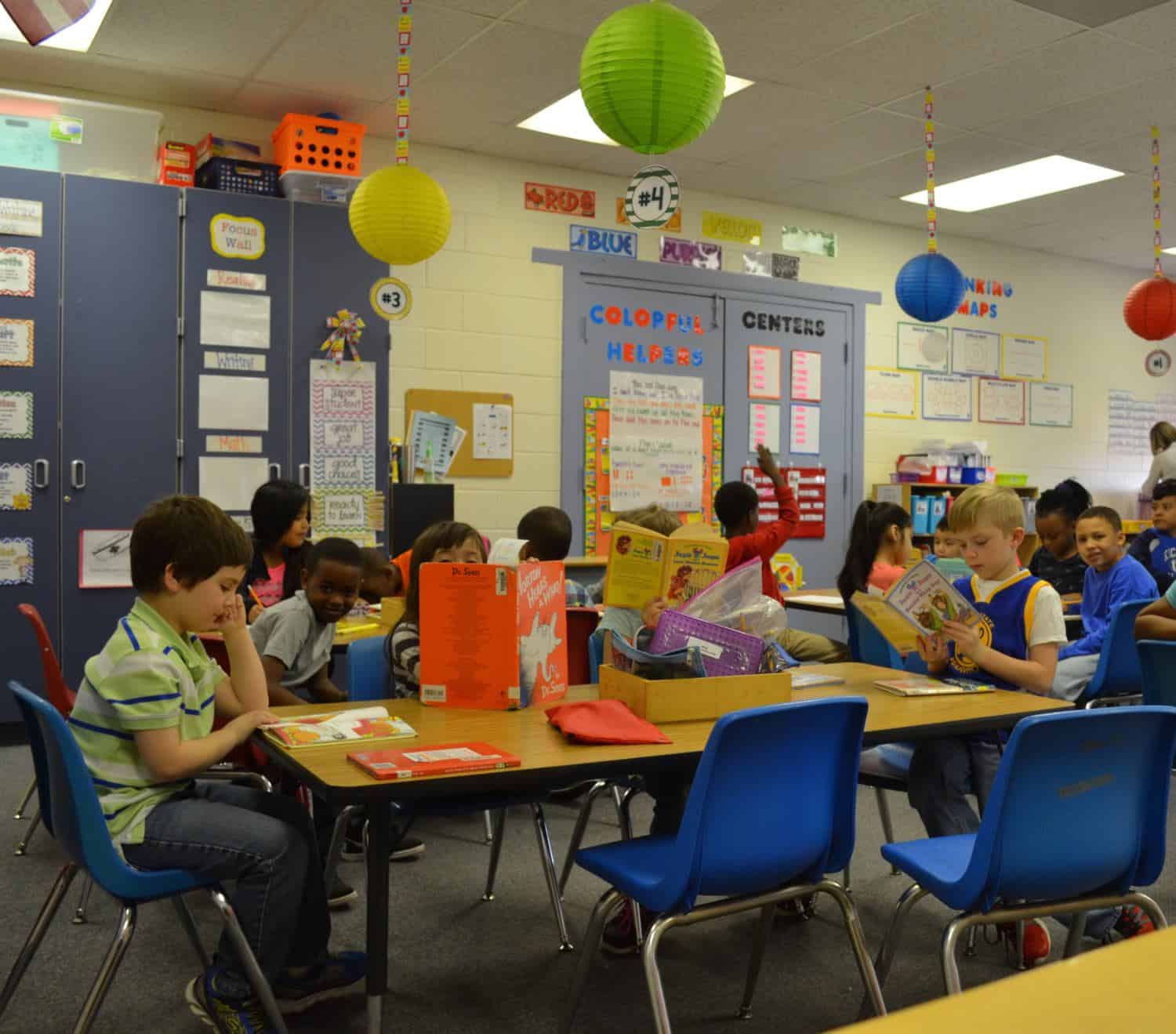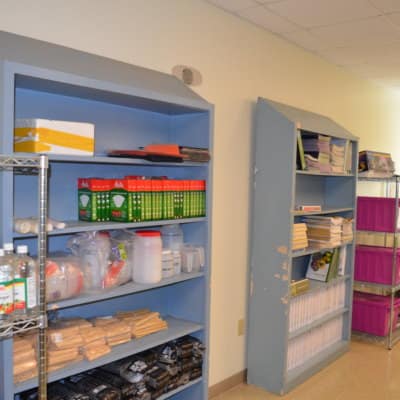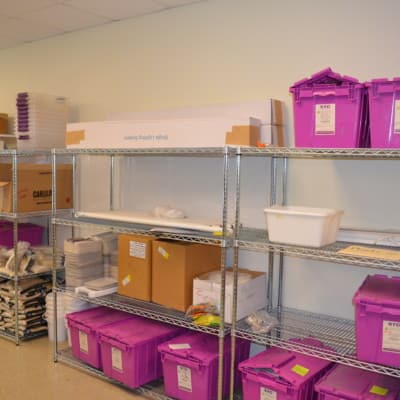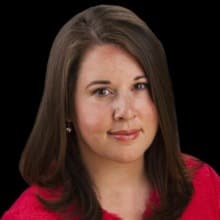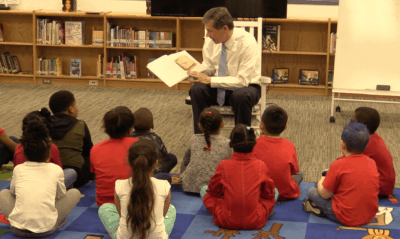RALEIGH — School systems across North Carolina say they will have to scramble to create hundreds of extra classrooms if a state requirement to reduce class sizes in grades K-3 takes effect next school year.
Where space is limited, some classes could be forced to meet in cafeterias or gyms, on school stages with the curtains pulled, or in teachers’ lounges. Schools could also add on to their buildings or truck in mobile classrooms, but with a tight timeframe and limited state funds to help with school construction costs, school leaders say those may not be viable options before next school year.
In Wake County, school leaders estimate they would have to hire another 460 teachers and create 400 new classrooms, totaling $320 million in personnel, capital, and operating expenses.
“How do we create 400 classrooms between now and Aug. 20? I don’t know how we do that,” said Bill Fletcher, a member of the Wake County Board of Education and chair of the facilities committee. “It takes a year to do mobile classrooms. It’s not an easy thing to do to add a mobile classroom.”
The Wake County Public School System has the greatest need in the state for school construction, according to the 2015-16 Statewide Facility Needs Survey. The report also found that public elementary schools in North Carolina are the grades most in need of classroom additions.
Seventy miles east in Greene County, school leaders say they are facing a similar dilemma. Two of their schools will be affected if class sizes are reduced. Superintendent Patrick Miller said he does not know how much it would cost to add more classrooms, but he estimates it would be somewhere between $800,000 and $1 million.
“We are one of the poorest counties in the state, according to any metric you look at,” Miller said.
Greene County is one of the least affluent districts in the state when it comes to local finances, according to a 2016 local school finance study by the Public School Forum of North Carolina. The study shows Greene County is in the bottom quartile of all districts — third from last for adjusted property values per student.
While the space issues faced by rural districts like Greene County might not be as great as those in metropolitan areas like Wake County, rural schools often have fewer resources to create facilities.
House passes class size fix; Senate investigating the issue
North Carolina school districts currently have some flexibility to make their average class size slightly larger than the size state officials use to calculate how many teachers to fund for each district. Historically, local school officials have used that flexibility to create and pay for teaching positions in non-core areas such as physical education, music, art, and languages and to help delay the need to build new classrooms when enrollment is higher than expected.
But last year’s budget bill included a provision taking away that flexibility for class sizes in kindergarten through third grade, beginning in the 2017-18 school year. The provision required all teachers funded by state allotment to teach in core areas, and the hard cap on class sizes would require most districts to add classrooms through the use of mobile units, new construction, or splitting up areas currently used for other purposes, such as gyms or cafeterias.
The class size ratio limits under last year’s budget bill are:
- Kindergarten: one teacher per 18 students
- First grade: one teacher per 16 students
- Second grade: one teacher per 16 students
- Third grade: one teacher per 17 students
To remedy what they call an unintended consequence of the budget provision, lawmakers have considered putting the class size cut on hold or giving schools more flexibility to exceed it. The House voted 114-0 in February to back a measure that would lessen the impact.
That measure, House Bill 13, does not change the lowered class size targets in K-3. Instead, it allows school districts’ average class size to exceed those targets by up to three students and allows individual classrooms to exceed the target size by up to six students, if needed.
For now, the bill appears to have stalled. It is presently with the Senate Rules Committee. It, has not been scheduled for a vote in the Senate, and it is not on any legislative calendars.
Sen. Chad Barefoot, R-Wake, co-chair of the Senate Education/Higher Education committee said the Senate is investigating the issue.
“We have asked school districts to provide data on where state dollars that were designated to reduce class size were being diverted,” he said in an email. “We will need to fully review that financial information before we can make an informed decision on whether school districts’ choice to divert these funds away from class size reduction was appropriate. After that, we will determine what needs to be done.”
While the topic of class size restrictions has been discussed in the General Assembly, it has also reached the ears of the state’s chief executive. Speaking last week from a child development center in Greensboro, Gov. Roy Cooper gave his opinion on the issue.
“If we’re going to put requirements on schools, we have to make sure that the funding is there,” he said.
However, Cooper admitted, there is no money in his proposed budget to address the burden that these restrictions could bring.
“We are ready, though, to talk about that issue,” he said.
As schools wait to see if lawmakers will ease class size restrictions, counties are already busy planning their budgets for next year. The class size unknowns may make it tough to plan, school leaders say, because a majority of school construction is funded at the local level.
Sen. Jerry Tillman, R-Randolph, discussed that issue in January.
“County commissioners are getting ready in March to start their budgets. They’ve got to know the impact as far as local dollars will be,” Tillman said. “School systems will be starting their budget (in February). So, everybody needs to know. We need to have this thing clarified.”
State funds can’t be used for mobile classrooms
The majority of public schools’ capital costs — buildings, equipment, etc. — come locally from the money generated by taxes on property values. The state contributes some money for school construction through the North Carolina Education Lottery, but not a large portion, according to Ken Phelps, an architect and school planning consultant for the North Carolina Department of Public Instruction.
Of the lottery money the state gives to public schools, 17 percent is allocated for school construction. The majority of the money, 63 percent, is for non-instructional support personnel.
“It’s not that it’s not appreciated,” Phelps said. “It’s very much appreciated and it’s very much useful, but in the whole scheme of things, it is a small part.”
And while public schools can use money from the lottery for school construction and repairs, they are not permitted to use it to buy mobile classrooms, according to Phelps.
“If they want to add an eight-classroom permanent building onto the school, they can do that with lottery money,” Phelps said. “But if they want to add an eight-classroom modular unit out in the parking lot, they can’t do that with lottery money because the lottery’s intended to be for permanent construction.”
Greene County Schools’ superintendent Miller said he knows firsthand how expensive mobile units can be. About a decade ago, when he was principal at West Greene Elementary, the district brought in a six-classroom mobile unit. Even without a bathroom or water hook-up, the unit was about $500,000.
Now as superintendent, Miller is considering mobile classrooms for one of his schools that could be impacted by the class size cap. He estimates Snow Hill Primary School, which serves grades K-1, would need an additional seven teachers, and thus, seven classrooms.
“I might have classroom space for three, maybe,” Miller said. “I guess I’d have to bring in mobile units or add on to the school which I have zero money to use.”
West Greene is the other school that would be affected. It houses the district’s second- and third-grade students and would need three more classrooms. Miller thinks he can use some non-classroom spaces in the school, but it will be a struggle.
“There is a mobile unit out there that’s got a couple of rooms that we are using for storage,” he said. “I could probably clean out some of those and cram the kids in, but it would not be ideal.”
While those “empty” rooms aren’t being used for classroom instruction, they do serve vital functions in many cases. One stores all of the school’s science equipment. Another room is used by the staff who keeps all of the school’s records, including attendance, student enrollment and withdrawal.
Another room is used for professional development for teachers. Sometimes, technology or other experts come in to give teachers lessons. If that room were converted into a classroom, teachers would no longer have a dedicated space for professional development, Miller said.
“This is the heartbeat of the district,” Miller said. “Everything accountability-wise for our students and staff is here.”
Finding space for classrooms isn’t the only issue Greene County and other districts face. Schools also need to provide all the equipment, including technology, in classrooms.
Tammy Noble, principal of Snow Hill Primary School, said that is one of things that fills her with anxiety.
“If we were to find seven rooms … that’s the simple part,” she said. “Filling the classrooms with everything a classroom needs to be ready to start on the first day of school … that’s totally different.”
While Greene County only has two schools that would be affected, some bigger rural districts would face considerably larger obstacles.
Principal: ‘We’d be working out of hallways and closets’
Just south of Winston-Salem, Davidson County Schools has 18 elementary schools that would need to find space for extra classrooms. Superintendent Lory Morrow said each of the schools would need anywhere from one to four more classrooms.
The schools might need to bring in modular classes, convert art and music classrooms, or turn media centers, tutoring spaces, and other support rooms into classrooms. The district is still studying the potential costs, but Morrow said they will be “significant.”
“And that’s the hard part for us as we’re trying to determine that now,” she said. “As we’re putting numbers together, we’re going to look at worst-case scenarios.”
With the restrictions scheduled to go into effect next school year, Morrow said districts across the state are going to have trouble getting schools ready to meet the needs of students.
Schools that need mobile classrooms may find themselves competing to purchase from the same supply. And if renovations are needed, districts will likely target some of the same contractors, she said.
The full process of adding a mobile classroom — including purchasing, transporting and installing it — can take about a year, according to Wake County school officials. The timeframe may differ by school system, but each district must submit their plans to the state to be reviewed, which also takes some time.
When schools want to add mobile classrooms, the North Carolina Department of Public Instruction checks everything from handicapped access to plumbing and lighting to make sure each mobile unit meets safety and educational requirements.
The review process typically takes a few days, according to Phelps, DPI’s architect and school planning consultant. If the workload is especially heavy, it may take two or three weeks before a school district is approved to add a mobile unit.
At Pilot Elementary School in Davidson, Principal Steve Reynolds said his building is already at capacity. The school could potentially bring in modular classrooms, but Reynolds is trying to see if he can creatively use existing space to make up the capacity for more classrooms. If the restrictions went into effect, the school would likely need at least four more classrooms.
Some options include converting tutoring, curriculum, and Title I rooms into regular classrooms. The school also has a pre-kindergarten class that might need to be displaced to make room for the extra classrooms.
But Reynolds doesn’t want to do any of those things. In the absence of those options, he said, he would have to take drastic measures.
“We’d be working out of hallways and closets, probably,” he said.
Reynolds also has a computer lab that he could empty to make room, but with the increasing emphasis on digital technology in schools, he said that would put Pilot Mill at a disadvantage.
“If everything is moving to digital, we need technology for our kids,” he said.
But not all rural districts face the dire consequences Davidson and Greene must handle.
Superintendent: ‘We’re going to make it work’
Leaders at McDowell County Schools, near Asheville, say they are fortunate. They converted the junior high schools, which served grades 7-8, into traditional middle schools, serving grades 6-8, a few years ago. The move opened up some space in the district’s elementary schools.
“We have to be creative, but I think physical space will be OK,” said McDowell County Schools Superintendent Mark Garrett.
But that doesn’t mean he’s happy about the changes. McDowell County allows students in its district to pick which school they want to attend. The district does not guarantee transportation for out-of-district students, but if the children can make it to the school, they can go there. The policy might have to change if there is no flexibility for K-3 classes.
Garrett said he is particularly frustrated with the General Assembly because when lawmakers hand down a mandate, schools must find a way to comply. Then, he said, districts are asked to do even more.
“We’re going to take care of kids, and we’re going to make it work because that’s what we’re here to do,” Garrett said. “It’d just be nice to have some flexibility to do the things locally that we know are going to make a difference for kids.”
Garrett says the class-size restrictions could cause another set of logistical problems. His county has a high number of students who fit the definition of homeless, though they may not necessarily live on the street. If they move between homes, they often transfer to different schools within the district.
“It’s not unusual for us to have kids who change schools two or three times a year,” Garrett said.
The situation could cause a problem if a school is already at capacity, and it may force schools to split up classrooms after the school year has already begun.
“You’re just chasing your tail,” Garrett said.
In Wake County, where school leaders estimate they will need to create 400 new classrooms, board member Bill Fletcher said school staff will do whatever is necessary to take care of students.
“We have very creative administrators. They will go and move their office to a car if they have to, to turn their office into a classroom,” he said.
Lawmakers who want to impose class size restrictions may have “perfectly valid intentions and desires,” Fletcher said, but they need to think about how schools will be affected.
“The effect that this particular mandate is having is going to be devastating,” he said.
This story was reported in partnership by EducationNC reporter Alex Granados and WRAL reporter Kelly Hinchcliffe. Additional reporting by WRAL’s Mark Binker and Laura Leslie contributed to this story.
